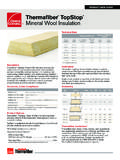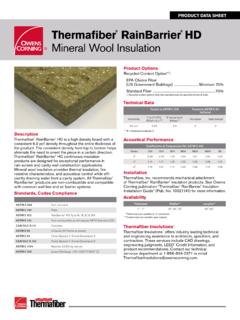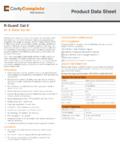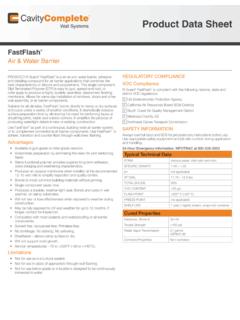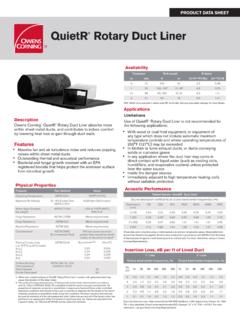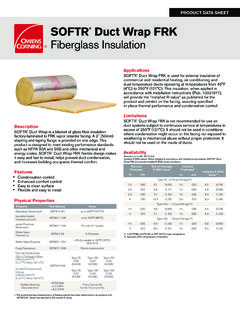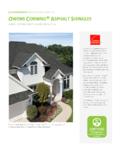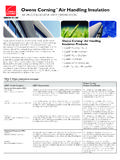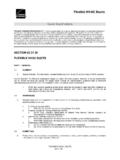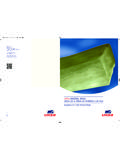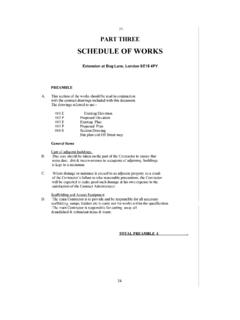Transcription of Environmental Product Declaration Mineral Wool …
1 Mineral wool BoardEnvironmental Product DeclarationThe North American Insulation Manufacturers Association ( NAIMA ) is the association for North American manufacturers of fiber glass, rock wool , and slag wool insulation products. The Association s role is to promote energy efficiency and Environmental preservation through the use of fiber glass, rock wool , and slag wool insulation, and to encourage the safe production and use of these materials. NAIMA advocates for improved energy efficiency in homes and buildings as the quickest and most cost effective way to reduce energy use and lower greenhouse gas saves 12 times as much energy per pound in its first year of use as the energy used to produce it. In fact, insulation in place in buildings reduces the amount of carbon dioxide emissions by 780 million tons per AMERICAN INSULATION MANUFACTURERS ASSOCIATIONM ineral wool insulation products, saving energy, reducing pollution, and contributing to a sustainable environment LIGHT AND HEAVY DENSITY Mineral wool BOARD According to ISO 14025 This Declaration is an Environmental Product Declaration (EPD) in accordance with ISO 14025.
2 EPDs rely on Life Cycle Assessment (LCA) to provide information on a number of Environmental impacts of products over their life cycle. Exclusions: EPDs do not indicate that any Environmental or social performance benchmarks are met, and there may be impacts that they do not encompass. LCAs do not typically address the site-specific Environmental impacts of raw material extraction, nor are they meant to assess human health toxicity. EPDs can complement but cannot replace tools and certifications that are designed to address these impacts and/or set performance thresholds Type 1 certifications, health assessments and declarations, Environmental impact assessments, etc. Accuracy of Results: EPDs regularly rely on estimations of impacts, and the level of accuracy in estimation of effect differs for any particular Product line and reported impact.
3 Comparability: EPDs are not comparative assertions and are either not comparable or have limited comparability when they cover different life cycle stages, are based on different Product category rules or are missing relevant Environmental impacts. EPDs from different programs may not be comparable. PROGRAM OPERATOR UL Environment Declaration HOLDER North American Insulation Manufacturers Association (NAIMA) Declaration NUMBER DECLARED Product Light and Heavy Density Mineral wool Board REFERENCE PCR PCR Building Envelope Thermal Insulation DATE OF ISSUE November 8, 2013 PERIOD OF VALIDITY 5 years CONTENTS OF THE Declaration Product definition and information about building physics Information about basic material and the material s origin Description of the Product s manufacture Indication of Product processing Information about the in-use conditions Life cycle assessment results Testing results and verifications The PCR review was conducted by.
4 UL Environment PCR was approved by Panel 333 Pfingsten Road Northbrook, IL 60611 This Declaration was independently verified in accordance with ISO 14025 by Underwriters Laboratories INTERNAL EXTERNAL Paul Firth This life cycle assessment was independently verified in accordance with ISO 14044 and the reference PCR by: Tom Gloria LIGHT AND HEAVY DENSITY Mineral wool BOARD According to ISO 14025 Page 2 of 14 North American Insulation Manufacturers Association NAIMA is the association for North American manufacturers of fiberglass, Mineral wool ( , rock wool and slag wool ) insulation products. Its role is to promote energy efficiency and Environmental preservation through the use of fiberglass and Mineral wool insulation, and to encourage the safe production and use of these materials.
5 NAIMA Mineral wool members include: Aislantes Minerales, de Mexico Armstrong World Industries Lancaster, PA Industrial Insulation Group, LLC Brunswick, GA Rock wool Manufacturing Co. Leeds, AL Roxul Inc. Milton, Ontario Thermafiber, Inc. Wabash, IN USG Interiors, Inc. Chicago, IL Product Definition Product Description Mineral wool insulation products come in myriad forms, shapes, and sizes, including: board; batt; loose fill; spray-applied; and pipe insulation. Whatever its form, Mineral wool insulation resists mold, fungi, and bacteria growth because the material is inorganic. Products also offer enhanced protection against damaging moisture infiltration that can rob insulation of R-value. Further, Mineral wool insulation is not corrosive and contains no chemicals that can degrade pipes and wires.
6 Mineral board materials are used in: curtain walls, commercial roofs, basement walls, floors over unheated or open spaces ( , garages or porches), and other building envelope applications. Board insulation is extensively employed in industrial processes. Further, the greater density of Mineral wool insulation allows the materials to achieve higher R-values and, thus, insulating power. This translates into increased year-round comfort and significant energy savings. In partitions, floors, and ceilings, the fibrous structure and high density of Mineral wool insulation offer sound absorption properties, making these products an excellent part of overall wall systems designed to reduce sound transmission [Crane]. Manufacturing Locations This EPD covers light density and heavy density Mineral wool board produced by manufacturers in the United States and Canada.
7 Production locations include facilities in Alabama and Indiana (United States), and Ontario (Canada). Results represent the production volume weighted average based on total mass produced by participating manufacturers. LIGHT AND HEAVY DENSITY Mineral wool BOARD According to ISO 14025 Page 3 of 14 Application and Uses The fibrous composition of Mineral wool insulation provides a flexibility and versatility not found in most other insulations. Mineral wool insulation comes in a wide variety of forms, shapes and sizes, including board, batt, loose-fill, spray-applied, and pipe insulation for many common and specialized applications. Applications include: Residential Thermal (walls and attics) Foundation drainage systems Acoustical (walls and ceilings) Commercial Thermal (walls and roofs) Fire stopping and containment Acoustical applications Acoustical ceiling tiles Industrial Thermal (ovens, boilers, kilns, etc.)
8 Fire stopping and containment Acoustical (sound absorbers) Emissions control Pipe/mechanical systems Fillers Installation Mineral wool products are made for easy handling and installation. Wherever insulation is installed in a building, it is very important that it fit tightly on all sides. Insulation should be installed just before the interior finish is applied. It is difficult to describe every situation that will be encountered by the insulation installer. In general, however, the installer should be guided by the need to reduce heat flow around or through obstructions and to protect mechanical systems. It is recommended that the installer follow the criteria developed by the Residential Energy Services Network (RESNET). Health, Safety, and Environmental Aspects during Installation The NAIMA Product Stewardship Program s work practices apply to the manufacture, fabrication, installation, removal, and other work settings where workers are subject to exposures to Mineral wool fibers.
9 The Product Stewardship Program commits manufacturers to use Product design, engineering controls, work practices, respiratory protection or a combination of any or all of these measures to bring fiber exposures to the voluntary one fiber per cubic centimeter permissible exposure limit (1 f/cc PEL). The Product Stewardship Program specifies comprehensive work practices for those working with Mineral wool fibers, including recommendations for cost effective engineering controls (when applicable), proper respirator use, use of protective clothing, and work place guidelines. In locations that require power sawing, routing, sanding, or grinding, or employ other operations that lead to dusty conditions, local exhaust ventilation should be used. LIGHT AND HEAVY DENSITY Mineral wool BOARD According to ISO 14025 Page 4 of 14 NAIMA has established an exposure database containing existing information about exposure levels categorized by Product type and specific work task.
10 Production Material Content Mineral wool insulation includes both rock wool and slag wool insulation, which are produced in the same way and comprised of essentially the same raw materials but in different proportions. Manufacturers use a mechanized process to spin a molten composition of rock and slag into high temperature resistant fibers. The similar properties of both insulation types lead to fairly similar performance attributes. The major difference is in the specific volumes of the various raw materials used to make each Product . Rock wool insulation is composed principally of fibers manufactured from a combination of aluminosilicate rock (usually basalt), blast furnace slag, and limestone or dolomite. Slag is a byproduct from steel production that would otherwise be landfilled.
